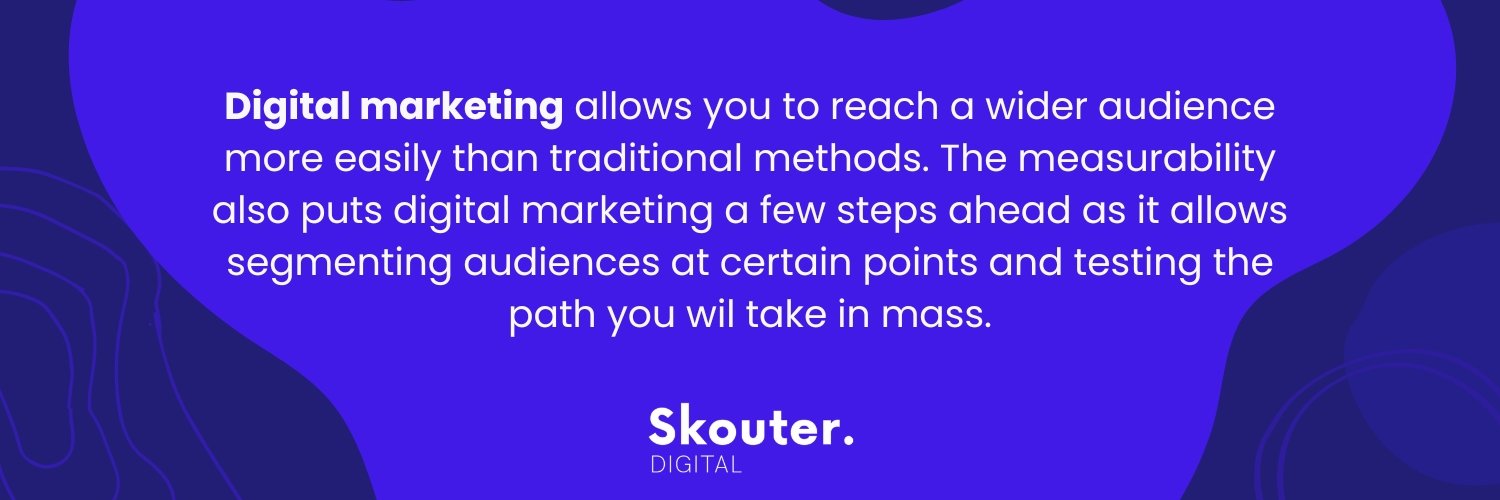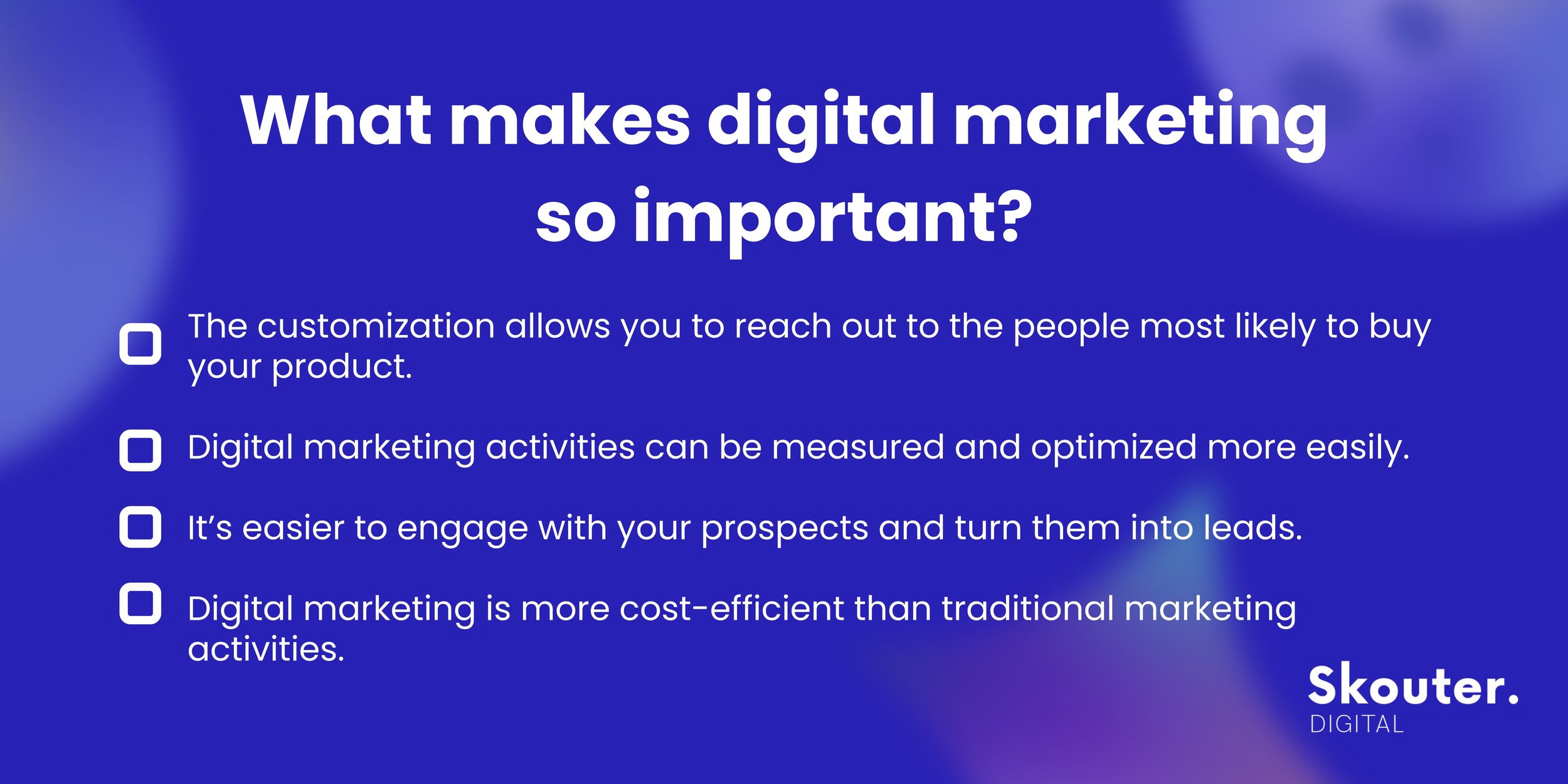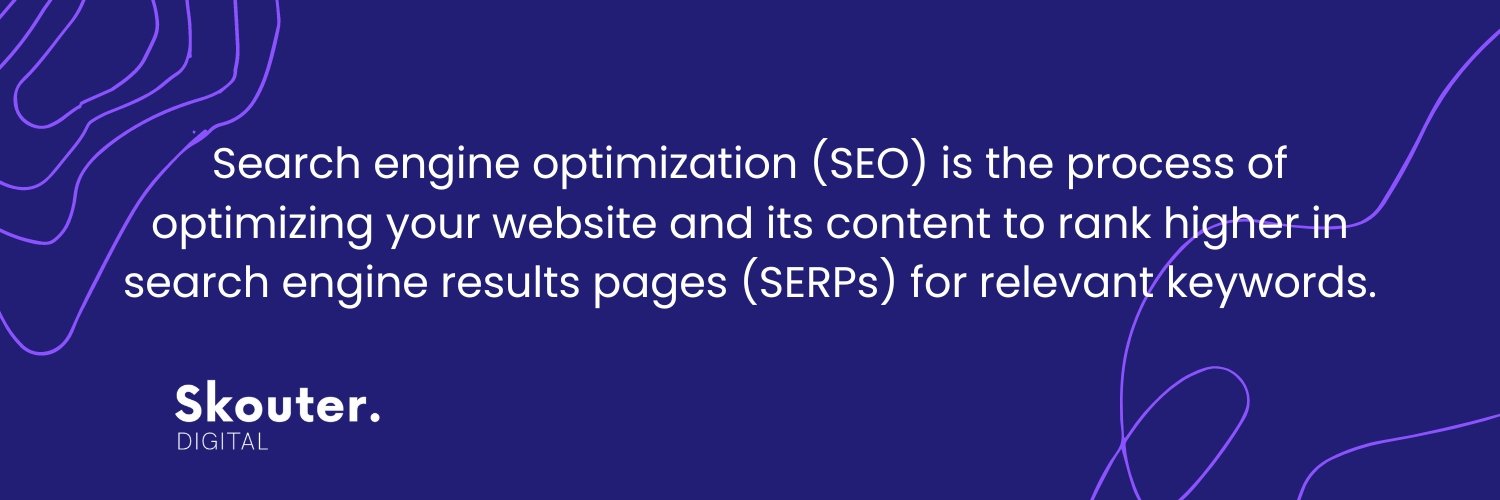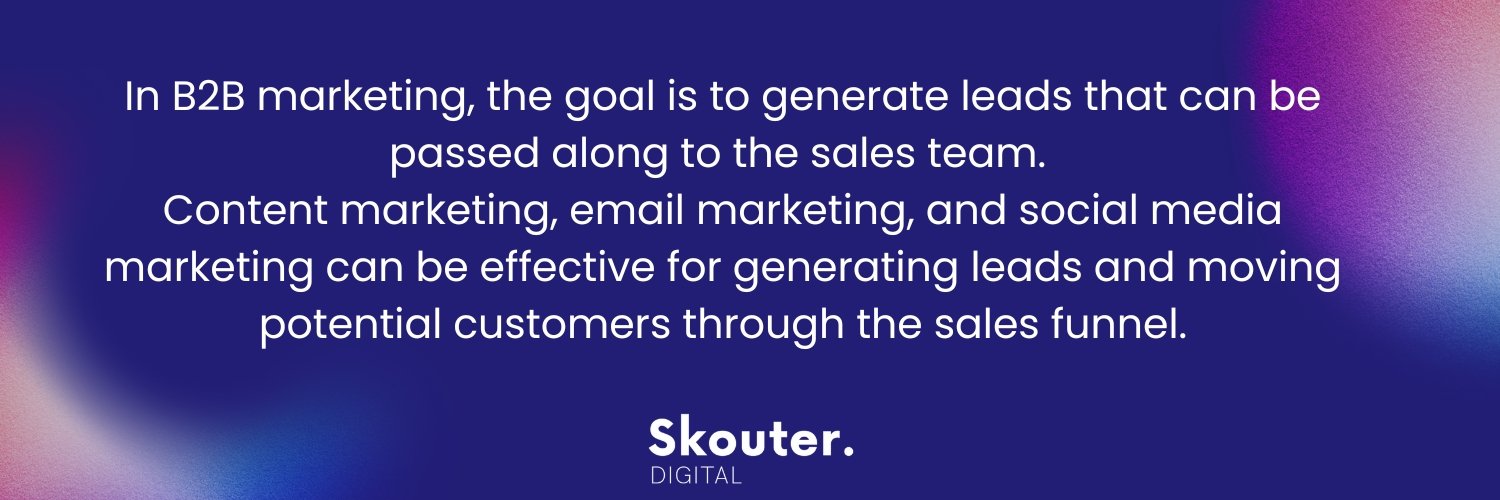Marketing is an essential part of any business's success, as it helps to attract and retain customers and drive sales. Your marketing strategy should help you figure out the most effective and cost-efficient way to reach your audience.
People's shopping habits have changed in line with the massive use of the Internet. So offline marketing can't be your only strategy because you need to reach audiences where they already spend time: online. So digital marketing is your solution.

We're aiming to give you a basic overview of what digital marketing is and how critical it is regardless of the type of business you have.
-
What is digital marketing?
-
What makes digital marketing so important?
-
What are the different types of digital marketing?
-
Is digital marketing effective for all businesses?
-
How to get started with digital marketing?
What is digital marketing?
In recent years, having a presence on the website and social media has become a critical issue for brands. As a result of easy access to digital resources that almost everyone can reach in 1-2 clicks, consumers have now adopted this method of gaining information about brands as their first stop for researching a product or service. As a result, brands have to adapt to different digital marketing tactics to get in front of users more or to reach them more effectively with the right information or message.
In these digital marketing tactics, as with any strategic approach, identifying the target audience at the very beginning and setting measurable and achievable goals will enable digital marketing experts to move forward more easily. Once these goals are set, adaptations can be made to different channels and methods. A content writer can produce quality content that will convert leads to the website. A social media specialist can promote this quality content on social media to make it more easily accessible. An email marketer can create an email campaign and send more detailed information to those who download the content. We will cover these specific streams in detail with other digital marketing tools.
What makes digital marketing so important?
The fastest answer: digital marketing allows you to reach a wider audience more easily than traditional methods. In addition, the concept of measurability puts digital marketing a few steps ahead. This measurability allows you to segment audiences at certain points and tests the path you will take in mass communication, or optimize your weekly or even daily actions to achieve more cost-effective results.
Let's take a look at some of the primary advantages of digital marketing:
-
Digital marketing's customization allows you to reach out to the people most likely to buy your product.
-
Digital marketing activities can be measured and optimized more easily.
-
It’s easier to engage with your prospects and turn them into leads with digital marketing.
-
Digital marketing is more cost-efficient than traditional marketing activities.

Let's take a more comprehensive look at the benefits of digital marketing and make them more clear for everyone.
1- Digital marketing's customization allows you to reach out to the people most likely to buy your product.
One of the key benefits of digital marketing is its ability to be customized and targeted to specific audiences. With the use of data and analytics, businesses can segment their audience and create personalized marketing campaigns that are more likely to resonate with their target audience.
For example, a business selling outdoor gear could use data on customer age, location, and interests to create targeted marketing campaigns for different segments of its audience. They might create a campaign targeting young, urban adventurers, another targeting families with young children, and another targeting retirees. By tailoring its marketing efforts to specific audience segments, the business can increase the effectiveness of its campaigns and reach the people most likely to purchase its products. Once the results of the first campaign are out, this business can use the existing data for custom audiences and lookalike audiences. This will enable them to reach new people who are more likely to respond positively to their second campaign.
In addition to segmenting their audience, businesses can also use data and analytics to personalize their digital marketing efforts. For example, they can use email marketing to send personalized messages to individual customers based on their purchase history or browsing behavior.
Overall, the ability to customize and target the efforts is a key advantage of digital marketing, as it allows businesses to reach the people most likely to be interested in their products or services and increase the effectiveness of their marketing efforts.
2- Digital marketing activities can be measured and optimized more easily.
One of the key benefits of digital marketing is the ability to easily track and measure the results of campaigns. With the use of analytics tools, businesses can see how well their digital marketing efforts are performing and make data-driven decisions about how to optimize their campaigns.
For example, businesses can track how many people are visiting their website, how long they are staying, and what pages they are viewing. They can also see how many people are clicking on their ads and how many are converting into leads or sales. This information can help businesses identify what is working well and what areas need improvement.
In addition to tracking website metrics, businesses can also use tools like email marketing software and social media analytics to measure the effectiveness of their campaigns. For example, they can see how many people are opening their emails, clicking on links, and making purchases, and they can track engagement on social media platforms like Facebook and Instagram.
Overall, the ability to easily measure and optimize digital marketing efforts is a key advantage, as it allows businesses to continually improve their campaigns and get the most out of their marketing efforts.
Once you have implemented a digital marketing campaign and started collecting data, it's important to regularly review and analyze the results to see how well your strategy is working. This can help you identify areas of your digital marketing strategy that are performing well and areas that may need improvement. This might involve changing the targeting of your digital marketing campaigns, adjusting your messaging, or testing new tactics.
By regularly reviewing and analyzing the results of your digital marketing efforts, you can optimize your strategy and get the most out of your marketing efforts.

3- It’s easier to engage with your prospects and turn them into leads.
Digital marketing provides a range of tools and tactics that can help businesses engage with their prospects and turn them into leads. The quality of your leads is an important factor in the success of your digital marketing efforts. High-quality leads are more likely to convert into customers and drive sales, whereas low-quality leads are less likely to be interested in your product or service and are less likely to make a purchase.
Some of the ways that businesses can engage with their prospects through digital marketing include:
Email marketing:
Email marketing allows businesses to send targeted, personalized messages to their prospects and nurture them through the sales funnel. By providing valuable content and targeted messaging, businesses can build trust and establish themselves as trusted resource for their prospects.
Social media marketing:
Social media platforms like Facebook, Instagram, and LinkedIn offer a range of tools and features that businesses can use to engage with their prospects. This can include creating and sharing valuable content, responding to comments and questions, and running targeted ads.
Social media marketing enables you to engage with your customers and target audiences.
Content marketing:
Creating and distributing valuable, relevant, and consistent content can help businesses engage with their prospects and build trust. This can include blog posts, videos, podcasts, and other types of content that provide value to the target audience.
Sustainability and consistency are two critical parts of a successful content strategy. Businesses focus to create content that can help their existent or potential customers, answer their questions, and drives them to a purchasing path.
Chatbots:
Chatbots are automated programs that can engage with website visitors in real time and provide answers to common questions. This can help businesses build trust and provide a better customer experience.
Overall, digital marketing offers a range of tools and tactics that can help businesses effectively engage with their prospects and turn them into leads. Creating valuable, relevant, and consistent content can help you attract the right audience and build trust with your leads. Also, you can use lead magnets.
Lead magnets are resources or incentives that businesses offer in exchange for a prospect's contact information. By offering something of value, businesses can attract higher-quality leads who are more interested in their product or service. By using lead qualification techniques, such as lead scoring or BANT (budget, authority, need, and timeline), you can identify the leads that are most likely to convert into customers.
4- Digital marketing is more cost-efficient than traditional marketing activities.
One of the main ways that digital marketing activities can save cost is through the ability to track and measure the results of campaigns. With the use of analytics tools, businesses can see how well their digital marketing efforts are performing and make data-driven decisions about how to optimize their campaigns. This can help businesses identify areas of their strategy that are working well and areas that may need improvement, allowing them to make adjustments and get the most out of their marketing efforts.
Another critical advantage of digital marketing is the ability to have complete control over where you choose to spend your money. With traditional marketing channels, such as print or television advertising, businesses often have little control over where their ads are shown or who sees them. With digital marketing, businesses can choose specific platforms and channels to advertise on and target specific demographics or interests.
For example, a business could choose to advertise on Google AdWords or Facebook Ads and target specific keywords or interests. They could also choose to advertise on specific websites or blogs that are relevant to their target audience. This allows businesses to have complete control over where their ads are shown and who sees them, resulting in a more targeted and effective marketing campaign.
In addition to choosing specific platforms and channels to advertise on, digital marketing also allows businesses to have complete control over their budget. With pay-per-click (PPC) advertising, businesses only pay when someone clicks on their ad, rather than paying for the ad to be shown. This means that businesses can control their advertising budget and only pay for the results they get.
Especially for small businesses with limited budgets, there are several digital marketing tactics that can provide a high return on investment (ROI) even with minimal spending. You can focus on social media, blogging, and search engine optimization (SEO) and by investing in these strategies, small businesses with limited budgets can still achieve a high ROI and drive growth through digital marketing.
What are the different types of digital marketing?
These are a few of the most common digital marketing tactics and channels. By using a combination of these tactics, businesses can effectively promote their products or services and reach their target audience in a cost-effective and measurable way.
We would like to take you deeper into this.
1- Content Marketing
Content marketing is a type of digital marketing that involves creating and distributing valuable, relevant, and consistent content to attract and retain a clearly defined audience. The goal of content marketing is to build trust and establish a business as a trusted resource for its target audience.
Some examples of content marketing include:
-
Blog posts: Creating and publishing blog posts on a company website is a common form of content marketing. These posts can cover a variety of topics that are relevant to the target audience and provide value to readers while showing your expertise to your target audience.
-
Infographics: ¨Show, not tell¨ is the ultimate digital marketing tactic when we talk about attractive content. Infographics are visual representations of information that can be used to explain complex topics in a simple and easy-to-understand way.
-
Videos: Videos: Video content is a type of digital marketing that involves creating and distributing videos to promote your business and engage with your audience. Video content can take many forms, including product demos, explainer videos, how-to guides, and promotional videos.
-
Ebooks: Ebooks are digital books that can be used to provide in-depth information on a specific topic or offer practical advice or tips to readers. One of the main benefits of content marketing is the ability to exchange content for a reader's contact information, also known as lead generation.
-
Webinars: Webinars are online seminars that businesses can use as a content marketing tactic to provide valuable information and engage with their audience. Webinars can be live or pre-recorded and can cover a variety of topics that are relevant to the target audience.
By creating and distributing valuable content, businesses can attract and retain a clearly defined audience and build trust with their target audience. This can help drive customer engagement and sales and improve the overall effectiveness of a digital marketing campaign.
2- Search Engine Optimization (SEO)
Search engine optimization (SEO) is the process of optimizing your website and its content to rank higher in search engine results pages (SERPs) for relevant keywords. By improving the ranking of your website in search results, you can increase the visibility of your business and attract more qualified traffic to your website.

There are many different factors that can impact the ranking of a website in search results, including:
On-page SEO: On-page SEO refers to the practice of optimizing individual web pages in order to rank higher in search engine results and earn more relevant traffic. On-page SEO involves optimizing the content and HTML source code of a page to make it more attractive to search engines. Ensuring that your website is well-organized and easy to navigate can help improve its ranking in search results.
Off-page SEO: Off-page SEO refers to the practice of building high-quality backlinks from other reputable websites to improve the ranking of a website in search engine results pages (SERPs). Backlinks are links from other websites that point to your website, and they are an important factor in determining the ranking of a website in search results. By building high-quality backlinks from other reputable websites, businesses can improve the ranking of their website in search results and attract more qualified traffic. However, it's important to focus on earning high-quality backlinks rather than trying to artificially manipulate search rankings through tactics like link buying or link schemes.
Technical SEO: Technical SEO refers to the practice of optimizing the technical aspects of a website in order to improve its ranking in search engine results pages (SERPs). Technical SEO involves optimizing the underlying code and structure of a website to make it more easily crawlable and indexable by search engines. Some elements of technical SEO include site speed, mobile friendliness, XML sitemaps, and structured data.
3- Social Media Marketing
This digital marketing activity includes using social media platforms, such as Facebook, Instagram, and Twitter, to promote your business and engage with your audience while driving traffic to your website and increasing your brand awareness.
Some benefits of social media marketing include:
-
Increased brand awareness: By promoting your business on social media, you can reach a larger audience and increase brand awareness.
-
Improved customer engagement: Social media platforms provide an opportunity for businesses to directly interact with their customers and build relationships.
-
Increased website traffic: By promoting your website on social media, you can drive traffic to your site and potentially increase sales.
-
Improved search engine rankings: By creating and sharing valuable content on social media, you can improve your search engine rankings and attract more qualified traffic to your website.
-
Cost-effective: Social media marketing can be a cost-effective way to reach a large audience and drive customer engagement.
Overall, social media marketing is a powerful tool for promoting your business and engaging with customers. By creating and sharing valuable content and interacting with your audience, you can build relationships, drive traffic, and increase sales.
4- Pay Per Click (PPC)
Pay-per-click (PPC) advertising is a type of digital marketing in which businesses place ads on search engines or other websites like Facebook, Linkedin, or Twitter and pay each time someone clicks on their ad. PPC is a way for businesses to reach their target audience and drive traffic to their website.
Some benefits of PPC advertising include:
-
Targeted reach: PPC allows businesses to target specific demographics and interests, ensuring that their ads are seen by the right people.
-
Measurable results: PPC provides detailed data on the performance of your ads, allowing you to track the success of your campaigns and optimize your strategy.
-
Quick results: PPC can drive traffic to your website almost immediately, making it a useful tool for generating leads and sales.
-
Cost-effective: PPC allows businesses to control their budget and only pay for the results they get, making it a cost-effective way to reach their target audience.
Overall, PPC advertising is a powerful tool for reaching your target audience and driving traffic to your website. By carefully targeting your ads and optimizing your strategy, you can achieve measurable results and improve the effectiveness of your digital marketing efforts.
5- Search Engine Marketing (SEM)
Search engine marketing (SEM) is a type of digital marketing that involves promoting a website through paid advertising on search engines. SEM includes pay-per-click (PPC) advertising and other forms of search engine advertising, such as shopping ads and local service ads.
By placing ads on search engines, businesses can reach their target audience and drive traffic to their website. SEM is a way for businesses to reach people who are actively searching for products or services like those offered by the business.
By carefully targeting your ads and optimizing your strategy, you can achieve measurable results and improve the effectiveness of your marketing efforts.
6- Email Marketing
Sending targeted and personalized emails to a group of individuals in order to promote a product or service, build relationships, or drive traffic to a website is basically called email marketing.
According to reach meaningful results first, you need to create your email marketing funnel. An email marketing funnel is a series of automated emails that are sent to a group of individuals over a period of time in order to move them through the customer journey and ultimately convert them into customers. By creating an email marketing funnel and targeting your emails to the appropriate stage of the customer journey, you can increase the chances of converting potential customers into paying customers.
Overall, email marketing is a powerful tool for promoting products, building relationships, and driving traffic to a website.
7- Influencer Marketing
Influencer marketing is a type of digital marketing that involves partnering with individuals who have a large following on social media or other platforms to promote your business or product. Influencers are typically individuals who have built a reputation for themselves in a particular industry or niche and have a large and engaged following.
Finding the right influencer for your business or product is an important step in any influencer marketing campaign. Here are some tips for finding the right influencer:
-
Identify your target audience: Clearly defining your target audience will help you find influencers who have a following that aligns with your target audience.
-
Research influencers in your industry or niche: Look for influencers who have a reputation in your industry or niche and a large and engaged following.
-
Look for authenticity: Choose influencers who are authentic and genuine, as this can help increase the credibility of your business or product.
-
Consider the fit: Look for influencers who align with the values and mission of your business, as this can help increase the authenticity of your campaign.
-
Analyze engagement: Look for influencers who have high levels of engagement with their followers, as this can indicate that they have a genuine and engaged following.
-
Don’t forget to measure the results. Even if you create a fully matched campaign, there will be no point in continuing it if you cannot convert it into sales.
By following these tips, you can find the right influencer for your business or product and increase the chances of success for your influencer marketing campaign.
Is digital marketing effective for all businesses?
Digital marketing can be effective for businesses of all sizes and industries. However, the specific tactics and strategies that are most effective will depend on the unique needs and goals of each business.
Some businesses may find that certain tactics, such as social media marketing or email marketing, are particularly effective for reaching their target audience and achieving their goals. Others may find that tactics such as pay-per-click advertising or search engine optimization are more effective for driving traffic and sales.
B2B Digital Marketing
In B2B marketing, the goal is often to generate leads that can be passed along to the sales team for further follow-up. Digital marketing tactics such as content marketing, email marketing, and social media marketing can be effective for generating leads and moving potential customers through the sales funnel.
It's important for B2B businesses to carefully consider their target audience and create marketing campaigns that are tailored to their needs and challenges. This may include developing high-quality, relevant content that addresses the specific needs of the target audience and using lead magnets to encourage potential customers to take the next step in the sales process.
Overall, B2B digital marketing is a powerful tool for promoting products or services to other businesses. By carefully considering the target audience, marketing channels, content, and lead generation tactics, businesses can achieve success in their digital marketing efforts.

B2C Digital Marketing
In B2C marketing, the goal is often to drive sales and conversions directly through the website or online platform. Digital marketing tactics such as social media marketing, pay-per-click advertising, and email marketing can be effective for reaching a large audience and driving conversions.
It's important for B2C businesses to carefully consider their target audience and create marketing campaigns that are tailored to their needs and preferences. This may include developing high-quality, relevant content that addresses the specific needs of the target audience and using calls-to-action and incentives to encourage potential customers to make a purchase.
Overall, digital marketing can be a powerful tool for B2C businesses looking to drive sales and conversions. By carefully considering their target audience and optimizing their digital marketing strategy, B2C businesses can achieve success in their marketing efforts.
How to get started with digital marketing?
If you're looking to get started with digital marketing, there are a few steps you can take:
-
Define your goals
-
Identify your target audiences
-
Research your competitors
-
Choose your digital marketing channels
-
Create a content marketing strategy
-
Optimize based on the analytics
1- Define your goals
Identifying and defining your goals is an important first step in any digital marketing campaign. Once you have clearly defined your goals, you can craft a strategy that is tailored to those goals and focused on achieving the desired results.
For example, if your goal is to increase brand awareness, you might focus on tactics such as social media marketing, content marketing, or pay-per-click advertising. These tactics can help you reach new audiences and increase the visibility of your brand.
On the other hand, if your goal is to drive traffic to your website, you might focus on tactics such as search engine optimization, social media marketing, or pay-per-click advertising. These tactics can help you attract more visitors to your site and increase the chances of converting those visitors into paying customers.
Overall, it's important to carefully consider your goals and choose tactics that are most likely to help you achieve those goals. This can help you create a successful digital marketing campaign and maximize the return on your marketing efforts.
2- Identify your target audiences
Identifying your target audience is an important first step in any digital marketing campaign. By understanding the demographics, interests, and needs of your target audience, you can tailor your marketing efforts to better reach and engage with those individuals.
For example, if you know that your target audience is primarily composed of young professionals, you might focus on tactics such as social media marketing or pay-per-click advertising to reach that audience. On the other hand, if you know that your target audience is primarily composed of small business owners, you might focus on tactics such as content marketing or email marketing to reach that audience.
Overall, identifying your target audience is critical for the success of your digital marketing efforts. By understanding who you are trying to reach, you can craft a strategy that is tailored to their needs and preferences and increase the chances of success.
3- Research your competitors
Researching your competitors is an important part of the digital marketing process, as it can help you understand what's already being done in your industry and identify opportunities for differentiation.
By researching your competitors, you can gain insights into their marketing strategies, target audience, and the products or services they offer. This can help you identify their strengths and weaknesses and develop a strategy that takes advantage of those opportunities.
For example, conducting keyword research is also an important part of this process, as it can help you optimize your website and content for search engines and ensure that potential customers can find your business through search results. By identifying the keywords and phrases that are most relevant to your business and the products or services you offer, you can optimize your website and content to rank well in search engine results and increase the chances of being found by potential customers.
Overall, conducting competitor research and keyword research are important strategies for improving your digital marketing efforts and ensuring that your business is competitive in the online marketplace.
4- Choose your digital marketing channels
Choosing the right marketing channels is an important part of the digital marketing process, as it can help you reach your target audience and achieve your marketing goals in the most cost-effective way.
There are many different marketing channels available, including social media marketing, email marketing, search engine optimization, pay-per-click advertising, and content marketing, to name a few. Each channel has its own unique strengths and can be effective for reaching specific audiences and achieving specific goals.
It's important to carefully consider your target audience and marketing goals when choosing your marketing channels. For example, if your target audience is primarily active on social media and your goal is to increase brand awareness, social media marketing might be a good choice. On the other hand, if your goal is to drive traffic to your website and generate leads, tactics such as search engine optimization or pay-per-click advertising might be more effective.
Overall, choosing the right marketing channels is a critical part of the digital marketing process. By carefully considering your target audience and marketing goals, you can select the channels that are most likely to help you achieve your objectives in a cost-effective way.
5- Create a content marketing strategy
Once you have a clear understanding of your target audience and marketing goals, you can start building your content strategy that is tailored to their needs and preferences. This can include various content types, such as social media posts, blog posts, pay-per-click ads, sponsored content, email marketing newsletters, and more.
It's important to carefully consider the audience and the marketing channel when developing your content. For example, social media posts might be more casual and conversational in tone, while email marketing newsletters might be more formal and informative.
It's also important to ensure that your content is high-quality, relevant, and valuable to your target audience. This can help you build trust and credibility with your audience and increase the chances of success with your marketing efforts.
Overall, creating content that is tailored to your audience and marketing channels is a critical part of the digital marketing process. By carefully considering your target audience and the channels you will use, you can create content that is effective in achieving your marketing goals.
6- Optimize based on the analytics
To create an effective digital marketing strategy for the long term, it's important to regularly review and analyze the results of your marketing efforts. This includes tracking key metrics such as website traffic, leads, and conversions, and using that data to inform your strategy.
By regularly reviewing your analytics, you can identify areas of success and areas for improvement, and make adjustments to your strategy as needed. This can help you stay on track and ensure that your marketing efforts are effective in achieving your goals.
It's also important to be flexible and willing to pivot based on the data. For example, if you find that a particular marketing tactic is not producing the desired results, it may be necessary to adjust your strategy and try something new.
Overall, regularly reviewing and analyzing your analytics is an important part of creating an effective digital marketing strategy for the long term. By staying on top of the data and being willing to pivot based on the results, you can ensure that your marketing efforts are successful and drive the desired results for your business.
If you're already doing digital marketing, it's likely that you are reaching some segments of your audience online. However, there is always room for improvement, and there may be areas of your strategy that could use a little fine-tuning.
Tags:
insights
%20(3).jpg?width=520&height=294&name=Guncel%20Skouter%20Blog%20Posts%20(1060%20%C3%97%20710%20px)%20(3).jpg)
.jpg?width=520&height=294&name=Skouter%20Digital%20Blog%20Posts%20(3).jpg)

Comments